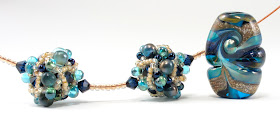For this month's Margie and Me Color Challenge, Marcie put forth two color palettes to choose from; the Amazon River-inspired palette #29 from Margie Deeb's The Beader's Color Palette, and a largely turquoise palette based off of this photo of a little medicine shop from a small village in Mexico:
Since I've been working with turquoise drop beads for another project, I went with the Village Corner palette. After some tinkering, I used this palette to create a larger version of my Pagoda beaded charm design as a pendant:
I hadn't originally intended to use the coral beads side-by-side; my first idea was to intersperse them throughout the pendant. But I like how they give little frames to the finished pendant, similar to the doors in the inspiration photo.
For this Pagoda beaded charm variation, I basically scaled up all the beads in the original design to a larger size; the 4 mm bicone crystals became 6 mm bicone crystals, the 15° seed beads became 11°, etc. I made some further adjustments to the design compared to the original, but the shape is essentially the same. Here it is side-by-side with an original Pagoda beaded charm:
Be sure to check out all the other Margie and Me challenge pieces on Marcie's blog. What techniques and strategies do you use to scale up an original design to a larger size?
































